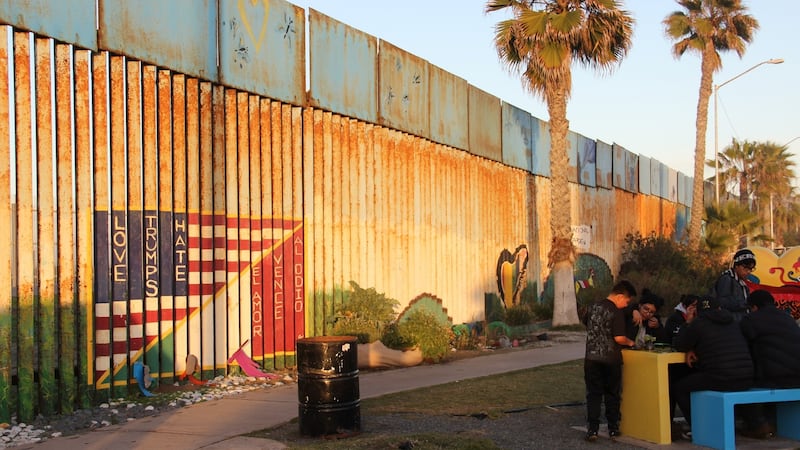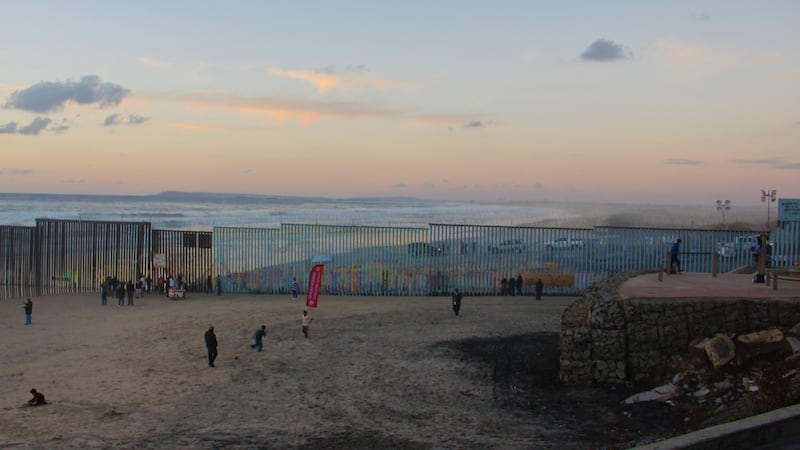On an empty, poorly lit street north of downtown Tijuana, a small group of people stand outside the high, galvanised entrance to the Youth Movement 2000 migrant shelter.
A TV camera crew records nearby. Behind the door, young men and women, mostly Honduran migrants, sit idly on plastic chairs next to camping tents as toddlers play on a carpet unfurled across the concrete floor.
For almost two months this has been home for "Simone" (20), from Colón in northeastern Honduras, who asked not to be identified as he felt speaking freely could negatively affect his asylum application. He says he left his hometown and joined a migrant caravan intent on crossing the US border because his life was endangered: two of his brothers, he says, were killed by drug cartels.
“Our family bought some land and they found gold deposits on it. The gangs wanted the land. I survived because I ran away,” he says. Simone, his thin figure hidden beneath a blue hoodie, stands less than 100m from the American soil he has travelled 4,500km to reach. Now he waits for his number to be called from a list compiled by migrants, so that he can apply for asylum in the US.
"Even if we don't get asylum, there is no way we can go back [to Honduras]." While many are thought to have returned home, crossed illegally to California or succeeded in getting their asylum cases processed, those who remain are finding life increasingly difficult.
City authorities have managed to keep their visible presence on the city streets to a minimum, providing food, water and housing for thousands at shelters and stadiums close to the US border. But now, months after they arrived, and with the prospect of entering the US fading in the face of a staunchly anti-immigrant administration in Washington and administrative bottlenecks at the border, the reality that their future lies in Mexico has begun to sink in. And that's a prospect that pleases few.
Humanitarian crisis
Tijuana, a hardscrabble city dependent on American tourist dollars and income earned by residents who commute across the border to work in San Diego, is finding itself under increasing strain. As migrants began descending on the city in October and November, authorities scrambled to distribute free meals and set up temporary shelters but were soon forced to declare a humanitarian crisis. The city of 1.6 million people is already struggling to come to terms with a murder epidemic fuelled by warring drug cartels.

Meanwhile, signs are growing that locals in Tijuana are increasingly fed up with the new arrivals. In November, several anti-migrant demonstrations were held, attracting hundreds of locals. Some have been outraged by reports that on November 24th a convicted Honduran murderer and a member of the MS-13 drugs cartel were arrested trying to enter the US by posing as migrants.
When migrants marched on the US consulate in Tijuana on December 11th to demand entry to the US or be given $50,000 to return home, severe traffic disruptions ensued.
A poll by a Mexican newspaper found that seven out of 10 people oppose the migrant caravans, and that half don't want to give them Mexican work permits, which the government has granted to migrants, as well as offering asylum. Mayor Juan Manuel Gastelum has taken a populist stance, claiming that members of the migrant caravan are "aggressive" and "vulgar". Last month, a Mexican federal judge ordered Gastelum not to spread negative messages about migrants, a ruling the mayor is appealing on freedom of speech grounds.
At the height of the crisis last month, the city was spending more than $27,000 a day on supplies at dozens of shelters and camps dotted around northern districts of the city. Honduras’s ambassador to Mexico has called on the migrants to return home.
Nor have migrants escaped Tijuana's violent flair-up that saw murders surge by 18 per cent last year – an average of seven people were killed every day.
The extent of migrants’ vulnerability was exposed last month when two Honduran teenagers staying at the Casa YMCA, a facility for housing migrant and other youths, were kidnapped and brutally murdered.
‘Kidnapped and tortured’
"Three boys decided to visit another shelter. They didn't tell us first and we noticed they were missing at about 6pm," says Uriel Gonzalez, the general co-ordinator at the Casa YMCA. "At around midnight, the surviving boy came back, deeply traumatised. He said a woman had approached them when they were near the Benito Juarez shelter. The boys went with the woman but were kidnapped and tortured [by two men] because they had no money to give the criminals."

The surviving boy, Gonzalez says, remains at risk and is being cared for by child services. Three people were arrested in connection with the murders and Gonzalez says the US government is partly responsible for the dangers facing migrants. “This administration has been clear about its rejection of asylum seekers,” he says.
Not everyone, however, opposes the newcomers. Close to the Pacific Ocean beachfront where the border fence protrudes into the rolling sea, three buildings have been converted to cater for recent arrivals. One serves as an on-site depot distributing food and clothing. Next door, a house owned by a local woman has been converted into sleeping quarters with more than 25 makeshift beds stacked three-high. The conditions, however, are damp and squalid with little natural light and no heating.
Simone says he has no idea how much longer he’ll have to wait until his application is processed but estimates it may take 10-15 days. He says Honduras became more dangerous in 2014, the year one of his brothers was killed. Three years later, a second was gunned down, and he and his family continued to receive death threats.
“We want,” he says, “to live in a safer place for my daughter.”
With a new caravan expected to set off from Central America next week, and two major shelters, including the Barretal camp which at one point housed 3,000 people, expected to close in the coming weeks, Tijuana’s migrant travails are unlikely to end anytime soon.










